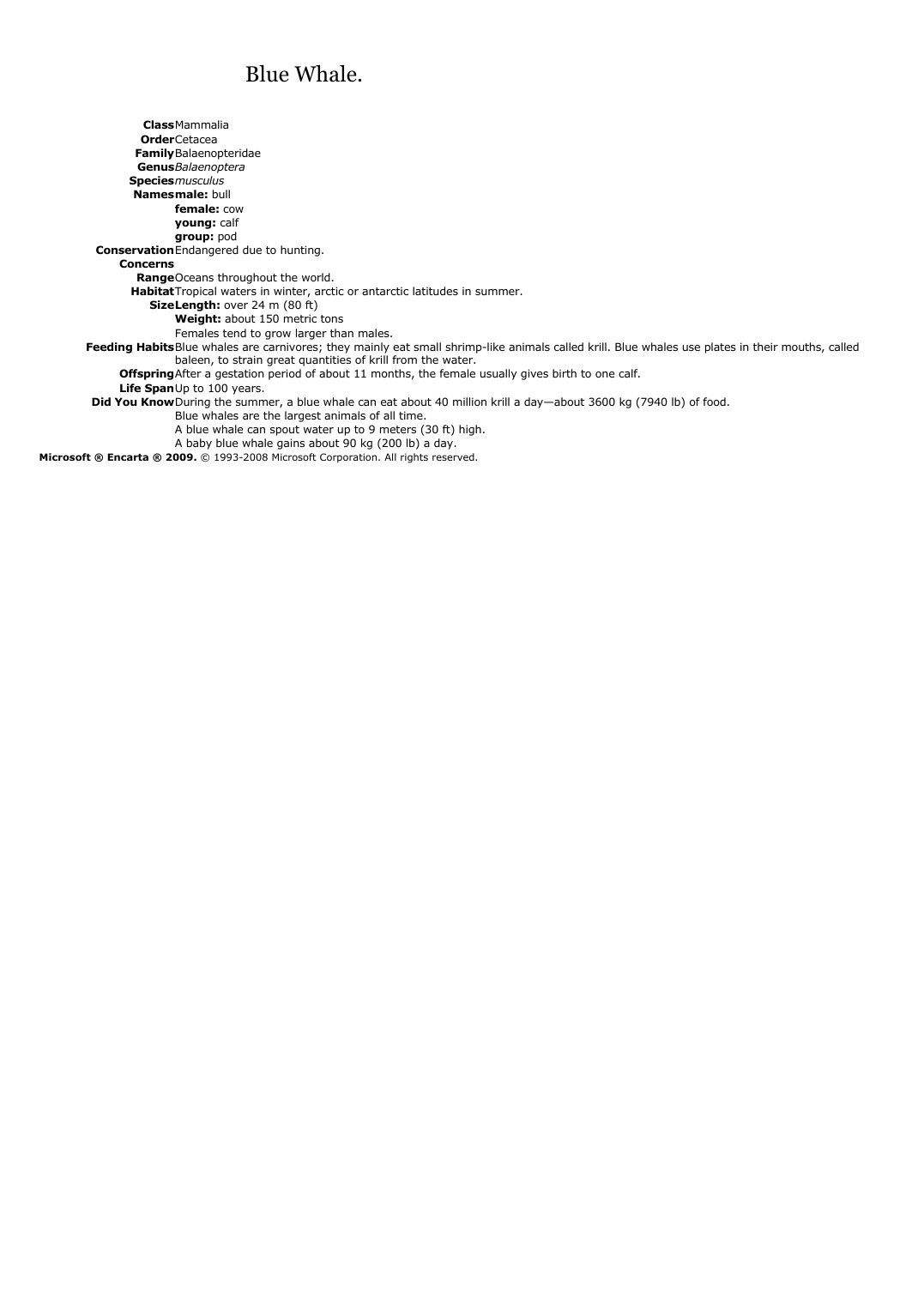Blue Whale.
Publié le 06/12/2021

Extrait du document
Ci-dessous un extrait traitant le sujet : Blue Whale.. Ce document contient 173 mots. Pour le télécharger en entier, envoyez-nous un de vos documents grâce à notre système d’échange gratuit de ressources numériques ou achetez-le pour la modique somme d’un euro symbolique. Cette aide totalement rédigée en format pdf sera utile aux lycéens ou étudiants ayant un devoir à réaliser ou une leçon à approfondir en : Echange
Blue Whale.
Class Mammalia
Order Cetacea
Family Balaenopteridae
Genus Balaenoptera
Species musculus
Names male: bull
female: cow
young: calf
group: pod
Conservation Endangered due to hunting.
Concerns
Range Oceans throughout the world.
Habitat Tropical waters in winter, arctic or antarctic latitudes in summer.
Size Length: over 24 m (80 ft)
Weight: about 150 metric tons
Females tend to grow larger than males.
Feeding Habits Blue whales are carnivores; they mainly eat small shrimp-like animals called krill. Blue whales use plates in their mouths, called
baleen, to strain great quantities of krill from the water.
Offspring After a gestation period of about 11 months, the female usually gives birth to one calf.
Life Span Up to 100 years.
Did You Know During the summer, a blue whale can eat about 40 million krill a day--about 3600 kg (7940 lb) of food.
Blue whales are the largest animals of all time.
A blue whale can spout water up to 9 meters (30 ft) high.
A baby blue whale gains about 90 kg (200 lb) a day.
Microsoft ® Encarta ® 2009. © 1993-2008 Microsoft Corporation. All rights reserved.
Blue Whale.
Class Mammalia
Order Cetacea
Family Balaenopteridae
Genus Balaenoptera
Species musculus
Names male: bull
female: cow
young: calf
group: pod
Conservation Endangered due to hunting.
Concerns
Range Oceans throughout the world.
Habitat Tropical waters in winter, arctic or antarctic latitudes in summer.
Size Length: over 24 m (80 ft)
Weight: about 150 metric tons
Females tend to grow larger than males.
Feeding Habits Blue whales are carnivores; they mainly eat small shrimp-like animals called krill. Blue whales use plates in their mouths, called
baleen, to strain great quantities of krill from the water.
Offspring After a gestation period of about 11 months, the female usually gives birth to one calf.
Life Span Up to 100 years.
Did You Know During the summer, a blue whale can eat about 40 million krill a day--about 3600 kg (7940 lb) of food.
Blue whales are the largest animals of all time.
A blue whale can spout water up to 9 meters (30 ft) high.
A baby blue whale gains about 90 kg (200 lb) a day.
Microsoft ® Encarta ® 2009. © 1993-2008 Microsoft Corporation. All rights reserved.
↓↓↓ APERÇU DU DOCUMENT ↓↓↓
Liens utiles
- Blue Ridge.
- BLUE VELVET
- ALPHA BLUE
- Réécriture de conte de fée: A Blue Beard that smells good
- OUT OF THE BLUE


